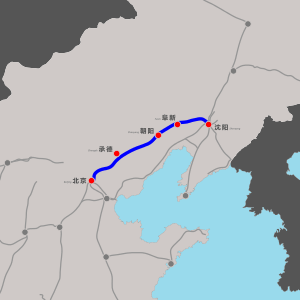Beijing–Shenyang High-Speed Railway
| Beijing–Harbin High-Speed Railway Beijing–Shenyang Section 京哈高速铁路京沈段 | |||
|---|---|---|---|
 | |||
| Overview | |||
| Type | High-speed rail | ||
| Locale | China | ||
| Operation | |||
| Owner | China Railway | ||
| Operator(s) | China Railway High-speed | ||
| Depot(s) | Shenyang, Harbin | ||
| Rolling stock | TBD: CRH380B series | ||
| Technical | |||
| Track gauge | 1,435 mm (4 ft 8 1⁄2 in) | ||
| |||
| Beijing–Harbin High-Speed Railway Beijing–Shenyang Section | |||||||||||||||||||||||||||||||||||||||||||||||||||||||||||||||||||||||||||||||||||||||||||||||||||||||||||||||||||||||||||||||||||||||||||||||||||||||||||||||||||||||||||||||||||||||||||||||||||||||||||||||||
|---|---|---|---|---|---|---|---|---|---|---|---|---|---|---|---|---|---|---|---|---|---|---|---|---|---|---|---|---|---|---|---|---|---|---|---|---|---|---|---|---|---|---|---|---|---|---|---|---|---|---|---|---|---|---|---|---|---|---|---|---|---|---|---|---|---|---|---|---|---|---|---|---|---|---|---|---|---|---|---|---|---|---|---|---|---|---|---|---|---|---|---|---|---|---|---|---|---|---|---|---|---|---|---|---|---|---|---|---|---|---|---|---|---|---|---|---|---|---|---|---|---|---|---|---|---|---|---|---|---|---|---|---|---|---|---|---|---|---|---|---|---|---|---|---|---|---|---|---|---|---|---|---|---|---|---|---|---|---|---|---|---|---|---|---|---|---|---|---|---|---|---|---|---|---|---|---|---|---|---|---|---|---|---|---|---|---|---|---|---|---|---|---|---|---|---|---|---|---|---|---|---|---|---|---|---|---|---|---|---|
Legend | |||||||||||||||||||||||||||||||||||||||||||||||||||||||||||||||||||||||||||||||||||||||||||||||||||||||||||||||||||||||||||||||||||||||||||||||||||||||||||||||||||||||||||||||||||||||||||||||||||||||||||||||||
| |||||||||||||||||||||||||||||||||||||||||||||||||||||||||||||||||||||||||||||||||||||||||||||||||||||||||||||||||||||||||||||||||||||||||||||||||||||||||||||||||||||||||||||||||||||||||||||||||||||||||||||||||
Beijing–Shenyang High-Speed Railway is a high-speed rail line under construction between Beijing and Shenyang cities in China. The line is 705 kilometres long. Construction was supposed to have started in 2010 with the project to be completed in 2012 but was delayed repeatedly until March 2014.[1][2]
Protests by residents along the planned route have caused several safety review to examine the potential noise pollution and electro-magnetic radiation.[3][4] The first two reviews suggested installing noise shielding along sensitive parts of the line. The third review called for similar noise shielding in addition to above ground tunnels to completely enclose the line while near urban areas.[5] In addition the starting point has been relocated to Xinghuo in Chaoyang district of Beijing. In August 2013, the Beijing municipal government published a notice calling for bids to build the line and work is expected to begin shortly with a planned completion sometime in the year 2018. The total investment is expected to be 124.5 billion yuan.[6][7]
The line will relieve a significant bottleneck in China's transportation network between the North East region and Beijing. The route will be north and inland of the existing communication lines which hug the coast around the Bohai sea. The new line will leave Beijing heading northeast to Chengde in Hebei province then turn east through Chaoyang, and Fuxi in Liaoning province, on route to Shenyang. There will be 16 stations, which will be the last section of the Beijing–Harbin High-Speed Railway to be completed; the other sections of that line have been operational since December 1, 2012.
The line will have a maximum design speed of 350 km/h[8] though regular services will operate around 200 to 300 km/h. Travel time between Shenyang and Beijing will be cut from the current 4 hours to just 2 hours and 17 minutes.[9]
See also
References
- ↑ "Beijing to Shenyang in 2 hours". China Daily. 8 August 2013. Retrieved 24 August 2013.
- ↑ "北京至沈阳铁路客运专线开建". 高铁网. 2014-05-07. Retrieved 2014-05-08.
- ↑ Tao, Anthony (10 December 2012). "Beijingers Protest Proposed High-Speed Rail Line". Beijing Cream. Retrieved 24 August 2013.
- ↑ Blanchard, Ben (2012-12-09). "Rare Beijing protest takes aim at high speed rail project". Reuters. Retrieved 2012-12-09.
- ↑ Chen, Xiaoru (22 November 2012). "Residents reject high speed railway's 3rd impact study". Global Times. Retrieved 24 August 2013.
- ↑ "Work starts on Beijing-Shenyang high speed railway". Shanghai Daily. 6 February 2009. Retrieved 24 August 2013.
- ↑ "High-speed railway to link Beijing, Shenyang|Society|chinadaily.com.cn". usa.chinadaily.com.cn. Retrieved 2016-04-12.
- ↑ "Beijing-Shenyang high-speed rail to break ground by year's end". People Daily. 19 March 2010. Retrieved 24 August 2013.
- ↑ "Beijing to Shenyang High-speed Rail Starts Construction This Year". Echinacities. 24 January 2011. Retrieved 24 August 2013.
